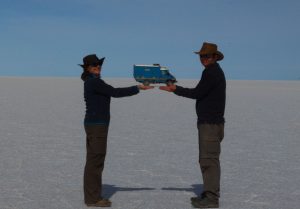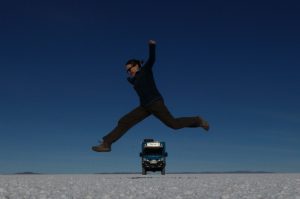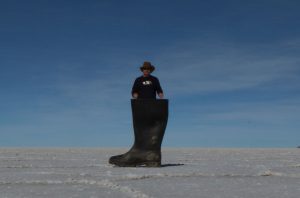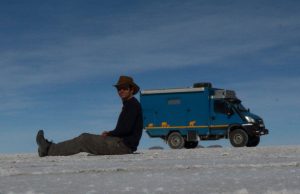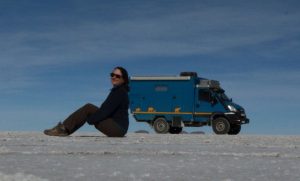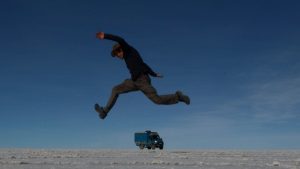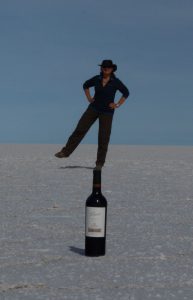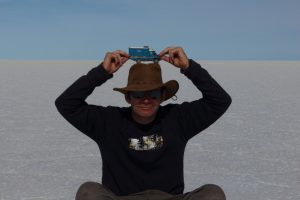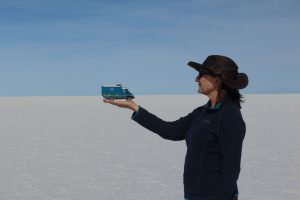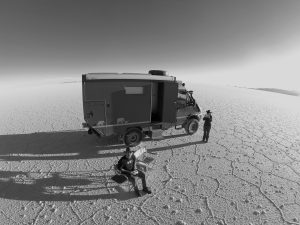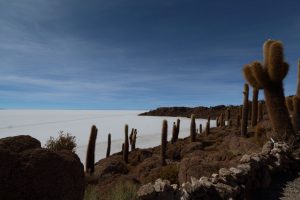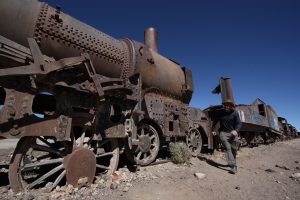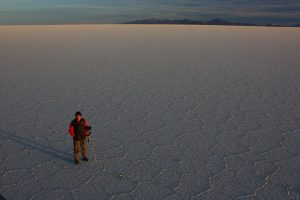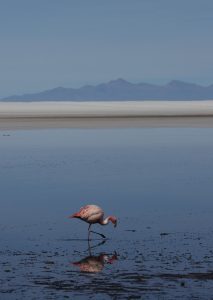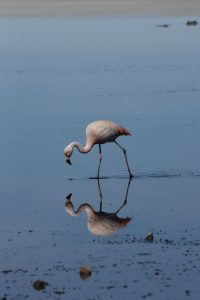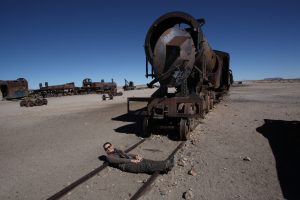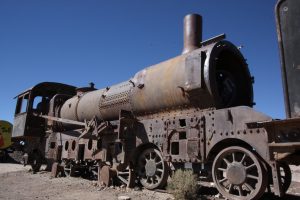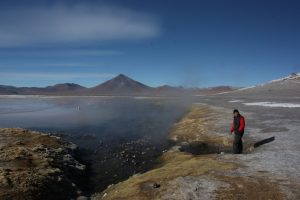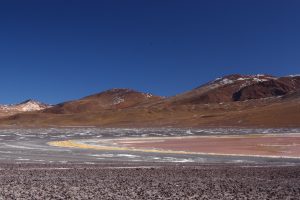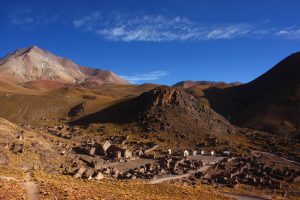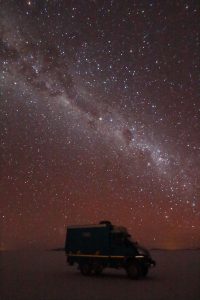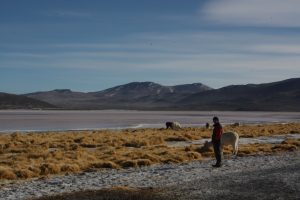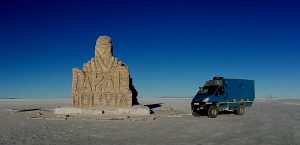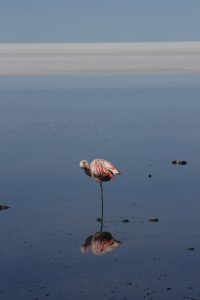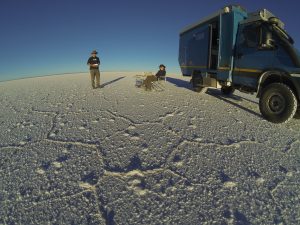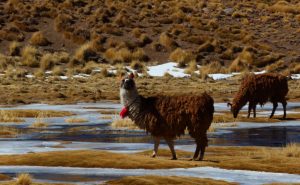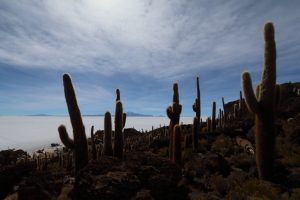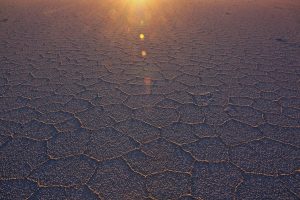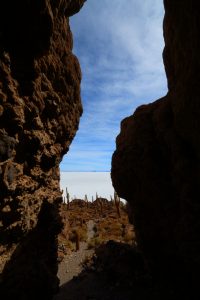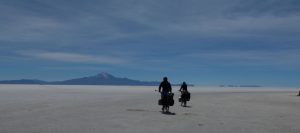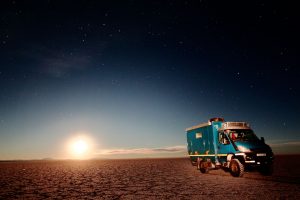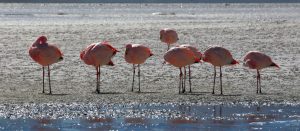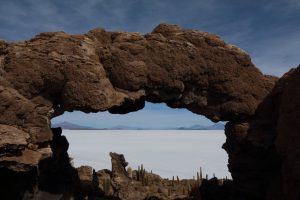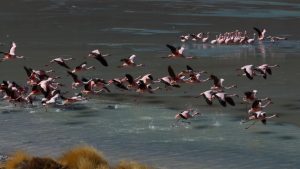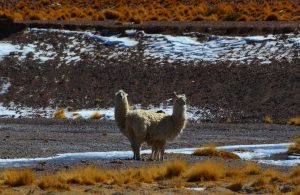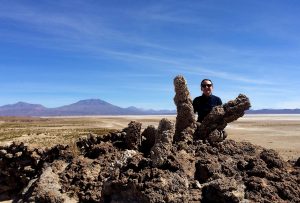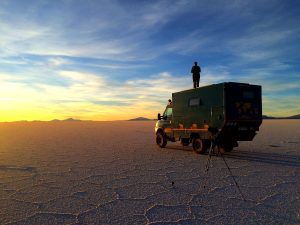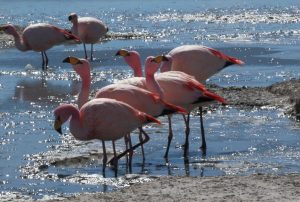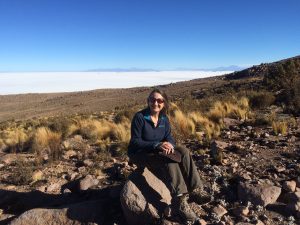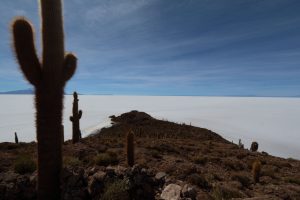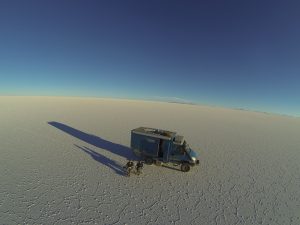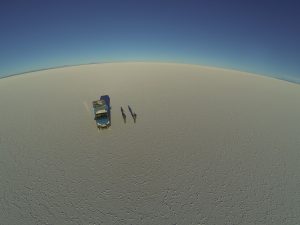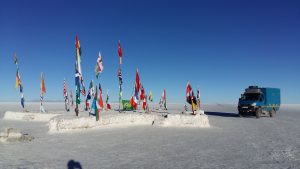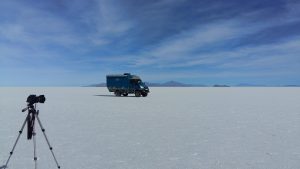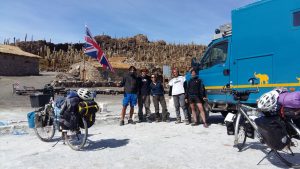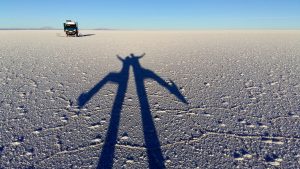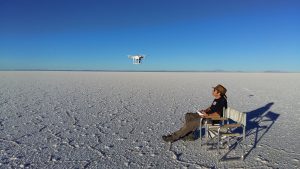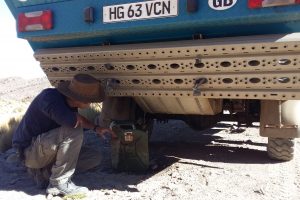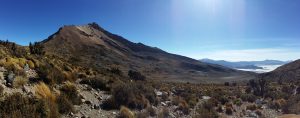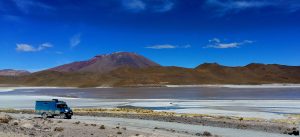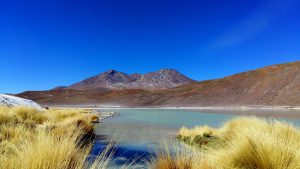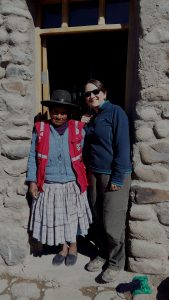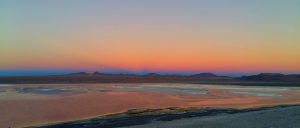We’re high. Very high. We’ve been plodding around the Bolivian altiplano, often at well over 4,000 m (13,000ft). After the central cities of Sucre and Potosí we’ve moseyed-on down to the remote south-west corner of Bolivia. Volcanos, lakes and the world’s largest salty-pan. We’re driving the Salar de Uyuni (see map).
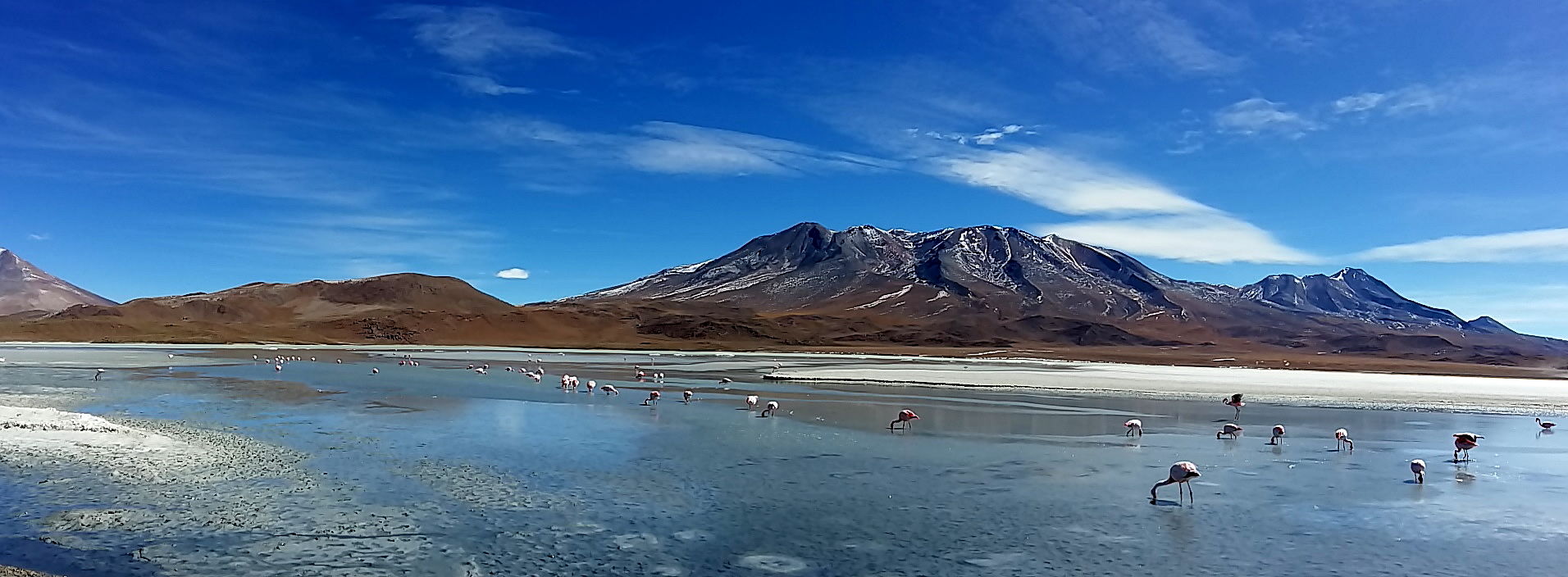
The Laguna Route
The route through the mountains and lagoons of far south-west Bolivia is said to be unmissable. It is also said to involve several hundred kilometres of punishingly rough tracks manageable only by 4×4/high-clearance vehicles. Well we’ve got one of those and we’re not afraid of a bit of rough stuff. But we still deliberated over whether we wanted to put Cuthbert and ourselves through the pain for such a long distance. We had already seen some pretty spectacular scenery on our previous time in the Andes. How much better could this actually be? Well we won’t know if we don’t go to see, will we? 🙂
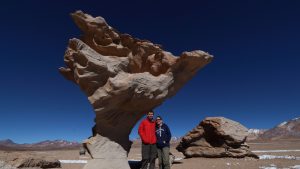 We started from Tupiza, notably the final playground of Butch Cassidy and the Sundance Kid. Circumstantial evidence indicates that in 1908 they carried out their final robbery just north of here before being corned, shot and buried in anonymous graves nearby. However, in 1991 when the bodies were exhumed, only the remains of a German miner were found! So where are they? Regardless of the mystery, the Tupiza valley area certainly does resemble the scenery of a wild west movie set.
We started from Tupiza, notably the final playground of Butch Cassidy and the Sundance Kid. Circumstantial evidence indicates that in 1908 they carried out their final robbery just north of here before being corned, shot and buried in anonymous graves nearby. However, in 1991 when the bodies were exhumed, only the remains of a German miner were found! So where are they? Regardless of the mystery, the Tupiza valley area certainly does resemble the scenery of a wild west movie set.
Climbing out of Tupiza up to the 4,000m+ plateau, the Laguna Route scenery is scattered with llamas grazing by icy lakes, between frozen streams and seams of un-melted snow. The mineral content of the water up here is so high that it is difficult to distinguish frozen water from salt-crust.
The route delivers the promised long and rough track but it also provides a never-ending succession of jaw-dropping views – time for a bit of ‘panorama’ action on our phone-cameras! The sky is unceasingly azure blue with rarely a cloud to be seen. In sheltered spots the sun is warm at around 20C, but the wind is bitter and at night it drops to a nippy -18C. Not many wildlife species can survive up here, but the llamas, vicunas and flamingos provide entertainment and a photographic challenge.
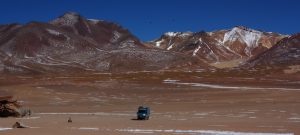 During the first half of the route we have this awesomeness all to ourselves and we see only one other vehicle in over 200km. Then we reach Laguna Colorada, a beautiful lake tinted red by algae and minerals, but O…M…G! 🙁 We have now intersected with the ‘Sardine Cruiser’ route. Every day, scores of Toyota Land Cruisers leave the town of Uyuni with travellers jam-packed-in like sardines. We’re grateful that with Cuthbert we can not only stay around and have the most popular places to ourselves after the scores of Sardine Cruisers have moved on, but we can also depart from the Sardine Cruiser Route and see other stunning areas.
During the first half of the route we have this awesomeness all to ourselves and we see only one other vehicle in over 200km. Then we reach Laguna Colorada, a beautiful lake tinted red by algae and minerals, but O…M…G! 🙁 We have now intersected with the ‘Sardine Cruiser’ route. Every day, scores of Toyota Land Cruisers leave the town of Uyuni with travellers jam-packed-in like sardines. We’re grateful that with Cuthbert we can not only stay around and have the most popular places to ourselves after the scores of Sardine Cruisers have moved on, but we can also depart from the Sardine Cruiser Route and see other stunning areas.
So was the Laguna Route experience worth the long, rough road? On balance – yes. Being fortunate enough to have a vehicle that can withstand the punishing environment meant that we could do the route in reasonable comfort. Cuthbert’s suspension rides the rough roads well and our central heating kept us in comfort with the cold. But if your vehicle isn’t prepared for these fairly extreme conditions, then the route is really not worth taking the risk. Even the Sardine Cruisers sometimes suffer damage, smashed exhausts and shredded tyres. We enjoyed the experience, but similarly beautiful scenery can be seen in other parts of the Andes on better roads.
Altitude
By anyone’s standards, a campsite at 4,600m is high. But for us Brits with our nation’s highest peak at a mere 1,300 m, this altitude is extraordinary. Until we came to South America we thought that a ski holiday at 1,800m in the Alps was high. Now we feel that descending to 3,600m is taking us to a comfort-zone!
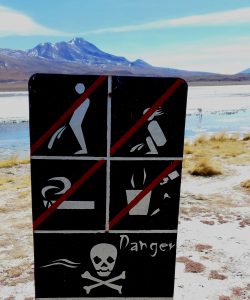
Warning for the Sardine Cruisers
Spending time at over 4,000m has several practical consequences for us. The first and most obvious is breathlessness due to the thin air; we have to take things slowly. We have had a bit of sleep disruption and there can also be an occasional mild ‘unwell’ feeling that’s difficult to put your finger on. The locals’ cure for this is to chew coca leaves sometimes together with bicarbonate of soda…… Ummm, we decided that we didn’t feel quite unwell enough to try this particular remedy, but we have found that the occasional cup of coca-leaf tea works wonders for a good night’s sleep 🙂
What other practical side-effects have we noticed…? Well… amusingly, we have had issues with exploding bottles – the ball of a roll-on deodorant literally exploded out of the bottle, spraying the liquid all over the bathroom walls! And here comes a top-tip for high-altitude cruising: choose Corona beer bottles over Stella! Our scientific study (okay, accidental discovery really) shows that at altitude, Corona bottles are less likely than Stella to leak their precious contents over the food in your fridge. Believe us, we know this from bitter experience.
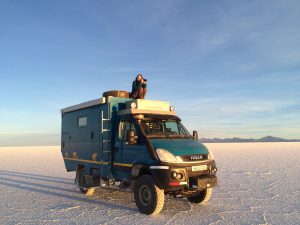 We have been particularly impressed with how Cuthbert has managed the altitude. With his Euro 5 diesel engine, it had been something of a concern for us. How will he cope with the low temperatures, the thin air and the reportedly poor quality fuel in Bolivia? Geeks interested in the full techie detail can read Marcus’ write-up (click here) but very briefly, he done good! The engine pre-heater and fuel filter heaters dealt with the low temperatures; the thin air caused a little sluggishness of initial acceleration but the turbos soon kick-in to deal with this. Poor quality diesel obtained from ‘no-name’ petrol stations did cause Cuthbert’s diesel particulate filter a few problems at altitude. But we soon realised that the better quality diesel available from the YPFB chain of fuel stations caused him no problems at all. Bravo Cuthbert!
We have been particularly impressed with how Cuthbert has managed the altitude. With his Euro 5 diesel engine, it had been something of a concern for us. How will he cope with the low temperatures, the thin air and the reportedly poor quality fuel in Bolivia? Geeks interested in the full techie detail can read Marcus’ write-up (click here) but very briefly, he done good! The engine pre-heater and fuel filter heaters dealt with the low temperatures; the thin air caused a little sluggishness of initial acceleration but the turbos soon kick-in to deal with this. Poor quality diesel obtained from ‘no-name’ petrol stations did cause Cuthbert’s diesel particulate filter a few problems at altitude. But we soon realised that the better quality diesel available from the YPFB chain of fuel stations caused him no problems at all. Bravo Cuthbert!
The Whiteness – driving the Salar de Uyuni
 The Salar de Uyuni is 10,500 sq km of pure white salt-pan, the world’s largest, sitting at around 3,700m at the north end of the Laguna Route. With its beautifully crystallised salt surface, there is plenty here to sprinkle on your chips. The vastness is spectacular.
The Salar de Uyuni is 10,500 sq km of pure white salt-pan, the world’s largest, sitting at around 3,700m at the north end of the Laguna Route. With its beautifully crystallised salt surface, there is plenty here to sprinkle on your chips. The vastness is spectacular.
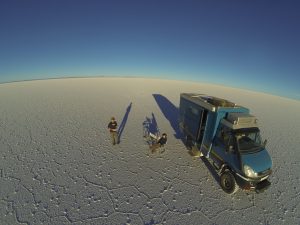 The salt-crust is up to 10 metres thick, making it safe in most areas to drive around on. Cruising out from terra-firma onto the dazzlingly white salt-crust is a surreal experience. The surface is crunchy and rough, but blinding and sparkles in the sunlight. Ray-bans required here! There are no fixed tracks, you just cruise-out into the almost infinite white, in any random direction. Most horizon references are lost on the huge scale of whiteness. The sparkling salt reaches the azure blue sky in a curvature-of-the-earth horizon, but there are a few distant volcanos and mountain peaks offering some directional guidance.
The salt-crust is up to 10 metres thick, making it safe in most areas to drive around on. Cruising out from terra-firma onto the dazzlingly white salt-crust is a surreal experience. The surface is crunchy and rough, but blinding and sparkles in the sunlight. Ray-bans required here! There are no fixed tracks, you just cruise-out into the almost infinite white, in any random direction. Most horizon references are lost on the huge scale of whiteness. The sparkling salt reaches the azure blue sky in a curvature-of-the-earth horizon, but there are a few distant volcanos and mountain peaks offering some directional guidance.
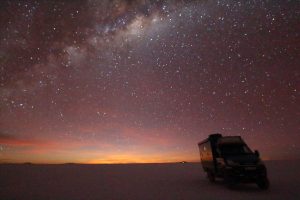 The majority of visitors arrive on organised day-trips from Uyuni, but the Salar is so huge that we see only a couple of distant vehicles over our four days spent out there, although we do meet a couple of crazy cyclists out there! We enter the pan and drive for an hour into the vast whiteness, then just stop in the middle. Surrounded by miles and miles of salt in all directions and not a soul to be seen from horizon to horizon
The majority of visitors arrive on organised day-trips from Uyuni, but the Salar is so huge that we see only a couple of distant vehicles over our four days spent out there, although we do meet a couple of crazy cyclists out there! We enter the pan and drive for an hour into the vast whiteness, then just stop in the middle. Surrounded by miles and miles of salt in all directions and not a soul to be seen from horizon to horizon
Once we have stopped and taken in the beauty of the surroundings, we go into overdrive with our cameras and out came the Phantom/Go-Pro for some great aerial shots. Marcus braved the bitter cold to take some amazing night shots of Cuthbert parked out under the stars. In the sunshine, the absence of geographical references in the environment creates a lack of visual perspective and it has become something of a tradition amongst travellers to think-up new and amusing ways take ‘trick of the eye’ photos. Not all of our attempts were successful, but here’s a few:
 From the Salar we took a detour to visit Volcan Tunupa on the northern shore. It has some caves with interesting mummies over 4,000 years old. We decided to see how far we could get Cuthbert up the steep and rough track up the side of the volcano. Diff-locks and low-ratio gears were engaged and we reached 4,630m, around 1,000m above the Salar. The views back over the pan were amazing. However, a less desirable consequence of the extremely rough track was a puncture hole in one of Cuthbert’s fuel tanks 🙁 Luckily there wasn’t much fuel in that tank. We have two other tanks to keep us going and Marcus was able to fix it a couple of days later.
From the Salar we took a detour to visit Volcan Tunupa on the northern shore. It has some caves with interesting mummies over 4,000 years old. We decided to see how far we could get Cuthbert up the steep and rough track up the side of the volcano. Diff-locks and low-ratio gears were engaged and we reached 4,630m, around 1,000m above the Salar. The views back over the pan were amazing. However, a less desirable consequence of the extremely rough track was a puncture hole in one of Cuthbert’s fuel tanks 🙁 Luckily there wasn’t much fuel in that tank. We have two other tanks to keep us going and Marcus was able to fix it a couple of days later.
We really loved it out on the Salar but after four days we had to move on. Our Bolivian visas are about to expire and we’ve only seen half of the country! Bolivia is really growing on us now, so we’re off to the mega-city of La Paz to ask the man nicely for a bit more time!
Link to next blog: La Paz Link to full South America Blog
Altiplano and Whiteness Video and PhotoGallery
- DCIM100GOPRO
- DCIM100GOPRO
- Uyuni Salt Pan – July-style
- DCIM100GOPRO
- DCIM100GOPRO
- Warning for the Sardine Cruisers

